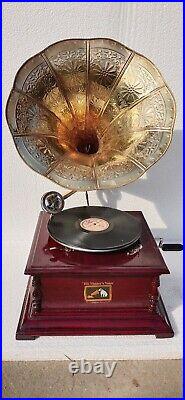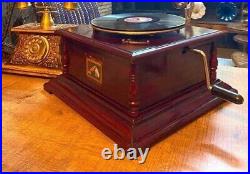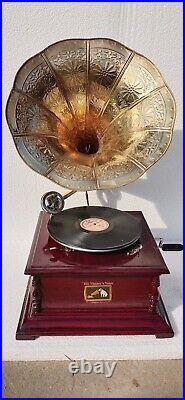Antique Gramophone Fully Functional Working Phonograph win-up record player





Gramophone Antique Design, Working Gramophone, win-up record player, Solid WOOD. These gorgeous style gramophone record players are portable, require no electricity and make an. Impressive and memorable gift. Full working order (sound quality sound) ready to play 78RPM recordings. Sturdy Seasonal wooden cabinet / base with authentic antique signs and Brass Horn. HEIGHT: 70 cm, WIDTH: 32 cm, DEPTH: 37 cm HORN: 37 cm. This product works 100% and can play vinyl. It is completely made of solid wood. There is no deformation, fracture or crushing. The product will be sent to you after the final checks. Compatible with stone slabs. THIS IS A GRAMAPHONE WITH EXCELLENT SOUND QUALITY. The gramophone, a pivotal invention in the world of music, revolutionized how we listen to and record sound. Here are some intriguing details. Invention and Early Days. The quest for a commercial music-playing and recording device began in 1877. Thomas Edison created the phonograph, but its sound quality was subpar, and it allowed only one playback and recording. In 1887, a German immigrant named Emile Berliner, who had settled in Washington DC, invented the gramophone. This device laid the groundwork for modern turntables and record players. Unlike the cylindrical phonographs of Edison, the gramophone played flat discs that were more portable and sustainable. The term “gramophone” emerged as an evolution from its predecessor, the phonograph. Berliner coined and patented the name “gramophone” to describe the advanced sound device that played flat discs on record players. These discs ran through grooves to the periphery, unlike the cylindrical phonographs. Alexander Graham Bell’s earlier invention, the phonautograph, also contributed to this transformation. While the first recorded audio in the phonograph is well-documented (it was “Mary Had A Little Lamb”), the gramophone’s initial recordings are less clear. In 1885, before commercial use began in 1887, two sound recordings were retrieved. A man reciting the opening lines of Shakespeare’s Hamlet. Another male voice reading the device’s description from its New Hampshire factory. How the First Gramophone Worked. The early gramophones had only four basic components. The groove on the disc. These simple elements produced sound, unlike today’s complex turntables and record players.
